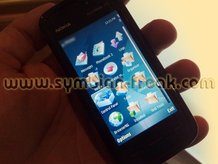Nokia Tube: outdated before it's begun?
Ancient OS could derail Nokia's plans for mobile domination with the 5800 XpressMusic

There's a lot of buzz around Nokia's new touch-sensitive handset, but could the underlying operating system cause it problems? It has a sexy codename (Tube), a cinematic endorsement (Morgan Freeman in The Dark Knight) and, perhaps importantly, brand new touch software that could challenge the iPhone's mobile supremacy.
But the actual Series 60 operating system is no spring chicken. In fact, with its origins in Psion software of the late 1990s, S60 software is positively antediluvian compared with Apple's newborn iPhone operating system. There's no denying that recent S60 handsets, even those like the Nokia N96 that use the latest S60 'feature pack', look dull and perform slowly compared with the iPhone's whisper-smooth animation.
The 5800 XpressMusic should arrive within weeks and will be first device to use S60 Touch UI, the latest incarnation of the Symbian-based S60. First announced nearly a year ago, the S60 Touch UI will feature haptic (tactile) feedback, support for stylus or finger input, and gesture control - albeit without the iPhone's full multi-touch interface. The Tube itself will sport an impressive combination of 3G, HSDPA, Wi-Fi, Bluetooth and GPS technologies.
Can Series 60 keep with the pace?
Ian Fogg, research director at Jupiter Research, sums it up: "Nokia phones have had step-by-step improvements but no radical breakthroughs for several years. S60 is fairly simple graphically, and they'll be looking to change that."
The move towards Symbian as an open source mobile platform, which started in June, is a mixed blessing. On the one hand, Nokia's new Symbian Foundation can call on the skills of members that include Sony Ericsson, Motorola, Texas Instruments, NTT, LG and Samsung. As Alain Mutricy, Senior Vice President of Motorola, says: "The Foundation will be able to leverage [the] unique experience, which includes expertise in touch technology."
It also scraps licensing fees and lets its customers choose where to source third party applications and handsets, in contrast to Apple's iron grip on all aspects of the iPhone. But as Ian Fogg notes: "It's easier to deliver an excellent experience on a single handset, like Apple. By being open, Nokia's S60 is making life harder for itself. Also, any cost reductions from licensing will take years to come through, with no effect on the market in the near term."
Sign up for breaking news, reviews, opinion, top tech deals, and more.
Where that openness pays off, though, is in the sheer reach of S60. After years of being found only on high end handsets, S60 is now moving into the mass market. The 5800, for instance, is only a mid-range handset that should be available for nothing with a contract or for a pocket-money price to pay-as-you-go customers.
Clever after all?
Fogg believes this will be a key point, especially in widening the appeal of touch. "Younger users in their teens and twenties are the heaviest users of digital activities but mostly use pre-pay and PAYG phones. Bringing S60 into the mainstream is the stuff that transforms markets."
Far from being outwitted by Apple, Nokia may have been playing a clever game all along. Apple has created an enormous demand for high quality touch phones that it simply isn't in a position to satisfy. If Nokia can offer a competent and stylish alternative to the iPhone at a fraction of the price, it's going to sell as many as it can produce.
Time is ticking away, though, and if Nokia wants to get the Tube into stockings this Christmas, it had better speed up - at least just a touch.
Mark Harris is Senior Research Director at Gartner.